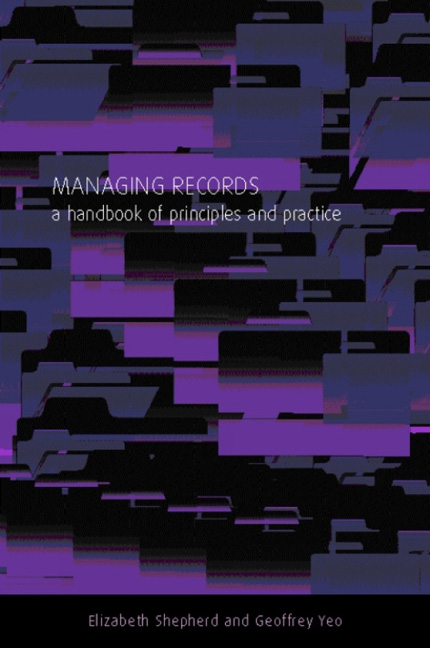Book contents
- Frontmatter
- Contents
- Preface
- Editorial note
- Introduction
- 1 Understanding records management
- 2 Analysing the context for records management
- 3 Classifying records and documenting their context
- 4 Creating and capturing records
- 5 Managing appraisal, retention and disposition
- 6 Maintaining records and assuring their integrity
- 7 Providing access
- 8 Implementing records management: practical and managerial issues
- Conclusion
- Appendix A Bibliography and sources of further information
- Appendix B Select list of national and international standards
- Appendix C Professional organizations for records managers in English-speaking countries
- Index
3 - Classifying records and documenting their context
Published online by Cambridge University Press: 09 June 2018
- Frontmatter
- Contents
- Preface
- Editorial note
- Introduction
- 1 Understanding records management
- 2 Analysing the context for records management
- 3 Classifying records and documenting their context
- 4 Creating and capturing records
- 5 Managing appraisal, retention and disposition
- 6 Maintaining records and assuring their integrity
- 7 Providing access
- 8 Implementing records management: practical and managerial issues
- Conclusion
- Appendix A Bibliography and sources of further information
- Appendix B Select list of national and international standards
- Appendix C Professional organizations for records managers in English-speaking countries
- Index
Summary
Records are kept to be used over time. The creator of a record may return to it to seek information or evidence of past activity. It is also likely to be used by others but, unlike the creator, later users may have little or no personal knowledge of the events surrounding its creation.
Completeness and reliability of the content of records are often the aspects of most concern to their creators. The context that gave rise to the record is usually self-evident to the creator, but may be less obvious to others who use the record in the future. To meet the needs of these later users, a record must carry sufficient evidence of its meaning and context to enable them to identify and interpret it correctly.
Building on the concepts discussed in Chapter 2, this chapter considers how records are classified and organized to ensure that contextual information is available and users’ needs are met.
Understanding the context of records
Context and classification
Users of paper records can usually gain some understanding of their meaning from their physical appearance and internal structure, and from data contained within the text. A user can distinguish a business letter from a private communication by its structure and format, and can identify the sender and recipient from the contents of the letter. Sometimes, however, essential data may be lacking; for example, the name or job title of the sender may have been omitted from the file copy of an outgoing letter.
If the letter has been filed with other related items, its context is also illuminated by its relationship to the other items in the file. Again, critical items are sometimes missing from files, so that the full context of those that remain is not apparent. However, paper records that have been filed systematically provide users with the structural and contextual information that is needed to reveal their meaning.
A key element that underlies the interpretation of records is the classification scheme, which in a paper-based system determines the identity of the file in which each item is housed and the place of each file within the records management system as a whole. Classification schemes play an equally important role in electronic records systems, where paper files do not exist, and in hybrid systems, where paper and electronic records exist side by side.
- Type
- Chapter
- Information
- Managing Recordsa handbook of principles and practice, pp. 72 - 100Publisher: FacetPrint publication year: 2003

